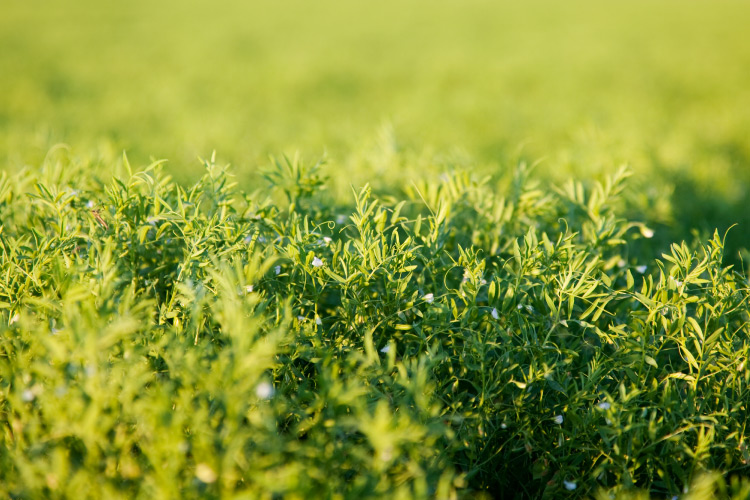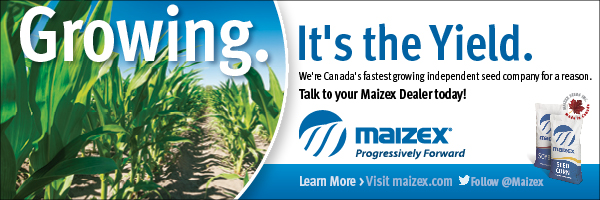Soybeans in Rotation With Peas and Lentils

By: Cheryl Manness
Crop rotations are designed to manage crop residues, optimize available moisture, improve organic matter, reduce inputs, improve weed management, and maintain or improve soil health.
Even though adding varied crops to a rotation increases the management required, it provides many benefits that make it worthwhile.
“Planning for pulses and soybeans in rotation provides a different plant growth habit that can help to alleviate disease, weed, and insect pressures of other crops in rotation,” says Daphne Cruise, Cropping Management Specialist with Saskatchewan Agriculture.
“Pulses generally harvest earlier which provides time for post-harvest weed control or fall cereals to be planted. More time is also allowed for soil water recharge as no crop is actively growing using up available water. Soybeans, however, often are the last crop to be combined due to their long maturity. This can take some time pressures off at the tail end of the harvest. Many crops mature at the same time and it can be stressful deciding which field to get to first. Soybeans have excellent shatter and lodging resistance and can remain standing in the field until the combines can get to the field.”
According to a study of three-year crop rotations outlined in the article “Diversifying crop rotations with pulses enhances system productivity”, “The global demand for grains such as wheat is forecast to increase by 100-110 percent by 2050 to meet the ever-growing human population’s need for food, feed, fiber, and fuel. Given the limited availability of uncultivated farmland on the planet and the growing concerns over converting carbon-rich forests and grasslands to cropland, most of the future increases in grain production will likely come from the existing farmland. Thus, alternative, pulse-based cropping systems, when used to diversify conventional summer fallow-based systems, can provide an opportunity to increase total grain production without exploring new farmland.”
In this study, carried out at the Semiarid Prairie Agricultural Research Centre in Swift Current, Saskatchewan by a team headed by Dr. Yantai Gan, a three-year cropping sequence was repeated for five cycles from 2005 through 2011. Overall, they found, “In a three-year cropping cycle, the pulse system increased total grain production by 35.5 percent, improved protein yield by 50.9 percent, and enhanced fertilizer N use efficiency by 33 percent over the summer fallow system. Consequently, the pulse system enhanced the fertilizer N use efficiency for grain by 99 percent and the fertilizer N use efficiency for protein yield by 186.6 percent, compared to the cereal monoculture. Diversifying cropping systems with pulses can serve as an effective alternative in rain-fed dry areas.”
“The production improvement with pulse systems was consistent regardless of the dry or the normal-to-wet conditions encountered in the present study. The inclusion of annual pulses in farming systems, either as a green manure or grain crop, has been shown to improve soil physical, chemical, and biological properties, reduce soil degradation, and enhance environmental sustainability.”
Rotating cereals with broad-leaved crops, such as oilseeds or pulses, allows weeds to be controlled with different herbicide groups, thereby reducing the risk of developing herbicide resistance. Incorporating this type of rotation into practice can also break the cycles of diseases, except for those that remain dormant in the soil or persist for long periods. Soybeans have increasingly become the crop of choice in Manitoba and some areas of Saskatchewan.
The Saskatchewan Soil Conservation Association article Crop Rotation, states that rotation planning begins with deciding on the proportions of the various crops to be grown in the rotation over the long-term and then developing a rotation strategy for the entire farm. When developing a rotation, consideration should be given to the benefit one crop will leave for the next crop planted. Each crop in the classic oilseed-cereal-pulse-cereal rotation benefits the succeeding crop in that it confuses the pests. The diseases common to broadleaf crops are not common to cereals and cereal diseases are not found in broadleaf crops.

The article goes on to say that volunteer weed management is also made easier by alternating crop types. With herbicides, it’s easy to remove a volunteer broadleaf from a cereal and a volunteer cereal from a broadleaf.
Cruise suggests, “The more time you can allow before you seed the same crop in a particular field again will help alleviate some disease, weed, and insect pressure.
“Soybeans tend to have higher tolerances for insect thresholds. It is a bit more elastic and can tolerate a bit more feeding pressure from insects, especially earlier on, compared to peas and lentils. The plant is also somewhat hairy, which can deter some insect feeding.
“Soybeans are susceptible to sclerotinia, which is something to watch out for, but so far we have not seen much pressure from this disease.
“RR and Clearfield varieties of lentil and soybeans allow for more options for weed control in-crop.”
According to Pulse Canada in their article “Sustainability”, “Although every crop in a diverse rotation is important and brings specific benefits, pulses have been shown to bring extra benefits to rotations. Pulse crops bring an advantage to cropping systems by leaving nitrogen behind for the following crop in the form of crop residues.
Manitoba Pulse and Soybean Growers claims, “By definition, soybeans are not a pulse because their seed is not dry, it contains high amounts of oil. MPSG includes soybeans in their portfolio because they are a legume and agronomically, they grow like a pulse, they are able to fix their own nitrogen and their seeds grow in pods.”
“Pulses and soybeans fix their own nitrogen,” says Cruise. “Little, if any nitrogen fertilizer is needed for these crops and, therefore, nitrogen fertilizer costs can be reduced. The decomposing plant material will contribute some nitrogen to the following crop, as well.”
Determining the right crop rotation for a specific field depends on several variables including weeds, diseases and insects present. The following is information from Manitoba Agriculture on a few of the crops.
Lentils like well-drained soil with the yield being severely reduced on wet, poorly drained soils as root diseases will increase. Lentils can be seeded early in the season, tolerating several degrees of frost with regrowth possible even if the above-ground portion of the seedling is damaged. Lentils are a relatively non-competitive crop and the herbicides for the control of some broadleaf weeds are either not available or provide less than acceptable control. Lentils must be sown to fields free of difficult-to-control perennial weeds such as Canada thistle and perennial sow thistle.
Field peas can also be seeded early in the growing season but are sensitive to a number of herbicide residues. As with lentils, the herbicides for the control of some broadleaf weeds are either not available or provide less than acceptable control.
Soybeans are more adaptable to all weather conditions; they can handle the extremes during the growing season. However, soybeans are more susceptible to spring frost, they are unable to recover if frost damaged. Soybean seedlings are not very competitive with weeds but most weeds can be managed effectively and inexpensively when planting glyphosate tolerant varieties.
“Soybeans can tolerate wet feet much better than lentils or peas,” states Cruise. “In recent years we have been receiving more rain, and this is part of the reason why they have gained popularity. Lentils do better in a drier climate as they can be more prone to disease. Peas are a fairly resilient crop, so are grown in most areas of the province.”
Cruise cautioned that lentils and peas are prone to Aphanomyces eutiches, a disease that seems to be gaining ground in Saskatchewan, however, soybeans are resistant to this particular root rot.
Root rot of pea and lentil is a disease that affects the below ground portion of the developing plant, leading to poor performing pulse crops, according to the publication Root Rot in Pea and Lentil in Western Canada. Unfortunately, once root rot has set in, there is nothing that can be done. In the case of Aphanomyces, it is important not to grow a susceptible host for a minimum of six years, maybe longer. Aphanomyces can infect peas, lentils, alfalfa, dry beans, some varieties of red clover, some varieties of fababean, and possibly some of the native weedy legume species. Soybeans are an option for a nitrogen fixing crop that is more resistant to Aphanomyces.
“Producers are always looking for ways to diversify their crop system when it comes to rotations, economics and logistics (seeding time, pesticide options, and harvest timing),” says Cruise. “We have had many years lately with more moisture than normal in many areas of the province. Peas and lentils seemed to be having some issues when it came to disease because of the moisture.
“Soybeans seem to do well in wetter conditions and can be planted further north than the typical lentil territory. Reduced inputs when it comes to disease and insect control are also an attractive upside for soybeans.”


